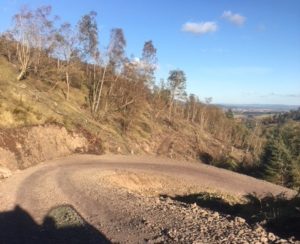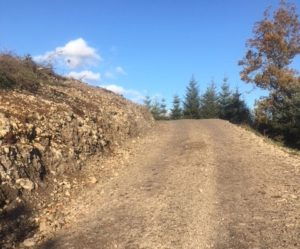The Roading Contractor (FWN 31)
30 September 2018Taking on the building of a new road may be one of the most daunting aspects of the harvesting process.
Indeed, it can be an expensive business but with proper planning, and the right advice, there’s usually a way to access even the most challenging sites. We spoke to John Dewar, of J.M. Dewar plant contractors, who has been building forest roads for more than 40 years, to find out what’s involved in building the infrastructure you need to harvest and extract your timber, and most importantly, how you can do this efficiently to maximise the financial returns from your wood.
If you’re only planting trees now, and harvesting seems like a long time away, it’s important to consider access at this stage. Think about how the trees could be reached from the existing infrastructure and don’t plant right up to the edge of roads – allowing in air and light will help the road to dry out and remain in good condition. An accessible woodland is a valuable woodland.
Planning the job
The process starts by walking the site with the roading contractor. At this stage, it’s important to understand all the constraints of the site, such as slopes, powerlines and watercourses, and explore all options for how and where you could extract the timber. Involving all the relevant people as early as possible will help you find a solution that works for everyone, so consider inviting the harvesting contractor, harvesting manager and/or forestry consultant to this first site visit. An experienced forest roads contractor will have a good understanding of harvesting but the harvesting contractor is the expert with experience of what infrastructure layout will work for their operations.
In considering all options, the landowner needs to balance the costs, including potential impacts on the rest of the farm or estate. For example, could you temporarily give over a field for timber stacking? Could the road be built in a way that would improve access to other areas, such as further forestry blocks to be felled at a later date?
Agreeing the specification, as well as the route of the road, at this early stage is key. An existing track may be a helpful start but will likely need significant upgrading in order to stand up to 44-ton timber lorries running on it 5 or 6 times a day.
The materials required to build the road can form the largest part of the total cost. However, this can be significantly reduced if you have rock on site which is suitable for road building. Using local “as dug” materials can sometimes reduce build costs by half. Even if the material needs to be blasted or crushed, depending on the scale of the project, this is usually far cheaper than importing rock from a commercial quarry. The potential savings of using on-site material mean it can be well worth paying for a few hours’ worth of excavator work to investigate. The disruption of extracting material from a borrow pit is temporary and topsoil can be reinstated afterwards.
Slope, terrain and ground conditions will influence how and where you can build the road. To overcome steep slopes on larger sites, roads can contour up round the hill. Over shorter distances the lower part of the road could be built up and lengthened to reduce the gradient. Forestry Commission guidelines suggest a gradient between 2% and 8% is best, with short sections up to a maximum of 12.5%.
Where the terrain is rough, it will be time-consuming and costly to break up large areas of rock. If it happens to be appropriate material for road building this could be economical. Otherwise, a longer route avoiding rocky areas will likely be more cost effective.
On soft ground, lowering the water table with drainage may be necessary before road construction, and an additional layer of larger rock may be needed. Peat is best avoided unless there is no other option. If peat is not too deep it can be dug out or drained, and the rock layer of the road can be floated on top of felled trees. On very deep peat there’s a risk that any type of construction could sink. As trees grown on peat are likely to have lower than average value timber, it’s important to weigh this carefully against the cost of extracting.
In addition to the road itself, there also needs to be stacking space for the timber, a turning area for lorries, plus space for parking and fuel bowser storage. The harvesting contractor should be involved in planning the layout, estimating how much stacking space is needed for the size of woodland and number of different products being cut. They are also best placed to decide where the stacking areas should be to allow harvesting to run efficiently.
Costs
Construction costs are calculated per linear metre of standard road, plus any additional work needed to deal with the specific challenges of the site, such as stripping away existing vegetation, cutting drainage, installing culverts or modifying the gradient. The source of the material will have the biggest impact on the total cost of the job. For example, the price of imported material would need to be compared with the cost of hiring blasting and crushing equipment to utilise on-site rock. The baseline cost of bringing in such equipment may be prohibitive on smaller-scale projects. However, if there’s a potential use for additional rock in the future, such as extending infrastructure to access further forestry blocks, scaling up material extraction could make it financially viable.
Timescale
It’s best to start putting the wheels in motion 18-24 months before you want to harvest to allow for unforeseen and bureaucratic delays. For any new forest road prior notification needs to be submitted to the local authority and if the new road will join a public highway planning permission is required. Existing junctions with public roads may need to be modified to create a bell mouth suitable for timber lorries.
When building a road on softer ground conditions there needs to be bedding in time before lorries start to use it. This can mean paying for a road many months before seeing an income from the timber but rushing road construction risks creating expensive problems and delaying harvesting, which delays timber payment.
While much of the road construction process can continue in wet weather, heavy downpours raise the risk of water pollution. Drainage and silt traps need to be checked and cleared regularly, and work must stop if sedimentation of watercourses is happening.
A well-built road can last decades if it is properly maintained. The lorry drivers should monitor the road’s condition on each visit and flag any necessary repair work long before the road deteriorates. However, landowners should check road condition regularly and everyone using it has a responsibility to look out for problems.
Potholes are best dealt with as soon as they start to form; once they open up and allow water to seep in this softens the formation, eventually causing the road to collapse. Maintaining a centre camber is also important for water run-off and, where possible, is preferable to a cross slope camber which is less stable for high-loaded lorries. Keeping on top of vegetation encroaching on the road, particularly over the longer term, can be more efficient than having to clear it once established. In rainy weather, a layer of wet vegetation on the surface of the road can reduce grip enough to stop lorries running. Roading contractors should aim to prioritise repair and maintenance work during harvesting to minimise delays and disruption to the timber lorries.
One of the most common types of damage is caused by a forwarder using band tracks running on the road. This usually happens when the layout of stacking areas and benches isn’t suitable so it’s important to discuss and agree the site layout with the harvesting contractor before any work starts.
Once you’ve invested in building a forest road it is worth the annual cost of maintenance to keep it in good condition for future use. A good road will aid restocking and helps make thinning and clearfell operations of the future crop more financially appealing.
Building a road for lorries all the way into the wood may not be the only option. If there is too little space for a turning area and stacking space within the wood, it may be better for the forwarder to extract the timber further, to where access for lorries is easier. The cost of the forwarder will increase with the extra distance it needs to travel but the cost of the road will be reduced.
If problems with the road arise once harvesting has begun anything that stops the lorries running efficiently will cost you money – the longer timber sits at the roadside the more it dries out and the lower the value when it goes across the weighbridge. While there’s always a risk of unforeseen events, most potential problems can be anticipated and planned for. Try to find a trusted local contractor who has experience on similar sites. Share with them all the information you can about your land and explore all the options.
Key points
- Plan ahead as early as possible
- Include everyone in planning from start
- Consider all options at the start – not always road right into wood
- Doing work up front usually better than having to deal with problems once the road is in use
- Finding roading material on site is worth the effort
Leona Baillie ,SAC Consulting & John Dewar J.M. Dewar Plant Contractor
Sign up to the FAS newsletter
Receive updates on news, events and publications from Scotland’s Farm Advisory Service


